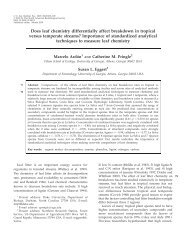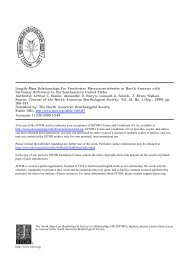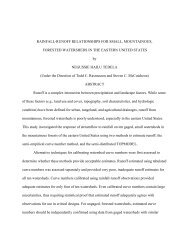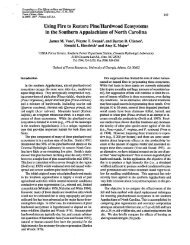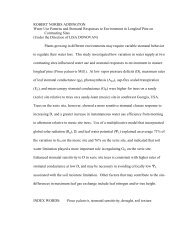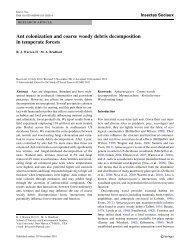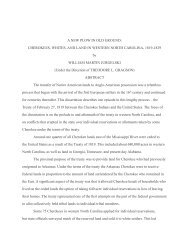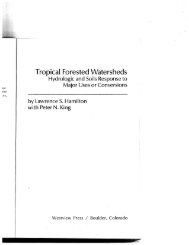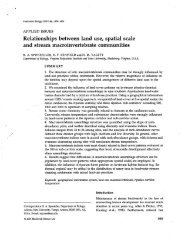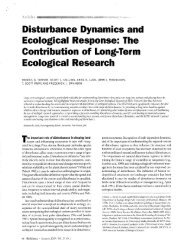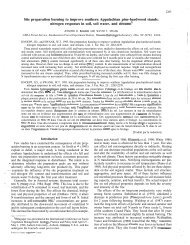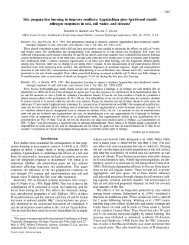biology join - Coweeta LTER - University of Georgia
biology join - Coweeta LTER - University of Georgia
biology join - Coweeta LTER - University of Georgia
Create successful ePaper yourself
Turn your PDF publications into a flip-book with our unique Google optimized e-Paper software.
Articles<br />
<strong>LTER</strong> Network and many additional partner sites, differ<br />
in their biophysical vulnerability to the coastal impacts<br />
<strong>of</strong> climate change. Some ecosystems along the US eastern<br />
seaboard will be more affected by sea-level rise and<br />
storm-surge severities, and others will be more affected<br />
by ocean acidification (e.g., coral reef communities in the<br />
south Pacific), the loss <strong>of</strong> sea ice (Antarctica), or changes in<br />
water temperature and freshwater inflows. Human vulnerabilities<br />
will also differ among regions, which arises from<br />
differences in coastal population density and demographic<br />
composition and from the location and resilience <strong>of</strong> the<br />
regions’ built infrastructure, which ranges from cities to<br />
drilling platforms. All <strong>of</strong> these effects and vulnerabilities<br />
need to be considered in concert in order to provide a comprehensive<br />
understanding <strong>of</strong> coastal-zone climate change<br />
and the potentials for future adaptation.<br />
The need to understand and anticipate the effects <strong>of</strong><br />
climate change, assess the vulnerabilities <strong>of</strong> natural and<br />
human elements <strong>of</strong> coastal systems, and adapt to or mitigate<br />
the effects <strong>of</strong> changes is prompting new efforts for integration<br />
across academic disciplines and creation <strong>of</strong> partnerships<br />
among academic, public, and governmental constituents.<br />
As for cryosphere loss, long-term studies are needed in<br />
order to document patterns and consequences <strong>of</strong> coastalzone<br />
change. Unlike cryosphere loss, however, coastal-zone<br />
change is likely to be strongly episodic in response to storm<br />
events that are projected to be increasingly severe and whose<br />
inland consequences will, in any case, be magnified because<br />
<strong>of</strong> sea-level rise. Posing questions relevant to networked sites<br />
in the context <strong>of</strong> a common model allows for a fundamental<br />
understanding more difficult to gain from shorter-term or<br />
more geographically discrete research.<br />
Key questions include (a) how the presses and pulses<br />
associated with coastal climate change—altered water temperature,<br />
precipitation, run<strong>of</strong>f, sea level, solar radiation, wind<br />
and wave climates, pH, and salinity—affect the structure and<br />
function <strong>of</strong> coastal ecosystems and what attributes affect the<br />
vulnerability <strong>of</strong> those ecosystems; (b) how climate-induced<br />
changes in coastal systems affect critical ecosystem services<br />
such as carbon sequestration, wildlife habitat, food-web<br />
support, and storm protection; (c) what attributes <strong>of</strong> human<br />
systems such as built infrastructure; land use; governance<br />
structures; and population demographics, including wealth<br />
and ethnicity, interact to influence human vulnerabilities to<br />
coastal climate change and how these interact with changes<br />
in ecosystem services to prompt responses <strong>of</strong> adaptation and<br />
mitigation; and (d) how mitigation and adaptation strategies,<br />
such as coastal engineering and reductions in greenhouse<br />
gases, would feed back to affect climate drivers and the structure<br />
and function <strong>of</strong> coastal systems. Effectively addressing<br />
these questions requires an approach that acknowledges and<br />
deeply explores the linked socioecological processes that<br />
underlie the delivery <strong>of</strong> almost all <strong>of</strong> the ecosystem services<br />
provided by coastal-zone environments.<br />
Many <strong>LTER</strong> Network sites are located in coastal zones<br />
at different latitudes along the eastern and western US<br />
seaboards, as well as in the South Pacific and Antarctic<br />
Oceans, and provide a diversity <strong>of</strong> geomorphologies and<br />
degrees <strong>of</strong> human influence, ranging from urban to exurban,<br />
rural, and natural. They are therefore well positioned<br />
to address a subset <strong>of</strong> these key questions, most <strong>of</strong> which<br />
will require a combination <strong>of</strong> long-term baseline data<br />
and experiments designed to predict the consequences <strong>of</strong><br />
sea-level rise for the ecology <strong>of</strong> coastal communities.<br />
Toward an environmentally literate populace<br />
Society’s ability to understand and act on the coupled<br />
natural and human systems on which we depend, built<br />
on a foundation <strong>of</strong> complex scientific inquiry, is key to a<br />
sustainable future. And it is the public—decisionmakers at<br />
all levels, from landowners and local <strong>of</strong>ficials to national<br />
leaders—who must act. The importance <strong>of</strong> an environmentally<br />
literate public is hard to overstate: From the grocery<br />
store and car dealership to the voting booth and corporate<br />
boardroom, individuals make choices that have far-reaching,<br />
collective consequences. Education helps to ensure that<br />
those choices are based at least in part on evidence and reasoning<br />
underpinned by solid scientific research.<br />
The <strong>LTER</strong> approach to research, combined with an ability<br />
to implement long-term educational initiatives, has allowed<br />
for unique approaches to the training <strong>of</strong> future researchers<br />
and to the conveyance <strong>of</strong> ecological concepts and insights<br />
to a broad constituency. At individual network sites, educational<br />
activities range from K–12 students and teachers<br />
engaged in schoolyard ecology to undergraduates involved<br />
in field classes and research internships and to graduate<br />
students and postdoctoral scholars learning to frame questions<br />
and to conduct research in long-term and sometimes<br />
cross-site contexts. Public outreach in many forms reaches<br />
working pr<strong>of</strong>essionals, as well as the general public, <strong>of</strong>ten<br />
through the education <strong>of</strong> those best positioned to communicate<br />
with the general public. This outreach is increasingly<br />
placed in a socioecological context, which illustrates<br />
the natural–human system couplings that are central to<br />
addressing major environmental issues and that are <strong>of</strong>ten<br />
hidden to many.<br />
The vision for education in the <strong>LTER</strong> Network includes<br />
leveraging both long-term and cross-site perspectives to<br />
advance fundamental science learning by K–12, undergraduate,<br />
and graduate students and developing programs<br />
for key constituent and underrepresented groups. These<br />
groups include K–12 teachers, university students, education<br />
policymakers, and the pr<strong>of</strong>essional public, which includes<br />
policymakers, natural-resource managers, the working<br />
media, and others whose success depends on access to and<br />
imparting <strong>of</strong> sound ecological knowledge.<br />
A long-term framework for environmental science literacy. Environmental<br />
science literacy—the capacity to participate<br />
in and make decisions through evidence-based discussions<br />
<strong>of</strong> socioecological systems—is essential not only for<br />
many science careers but also for responsible citizenship.<br />
348 BioScience • April 2012 / Vol. 62 No. 4 www.biosciencemag.org



